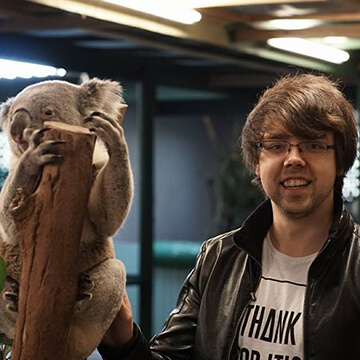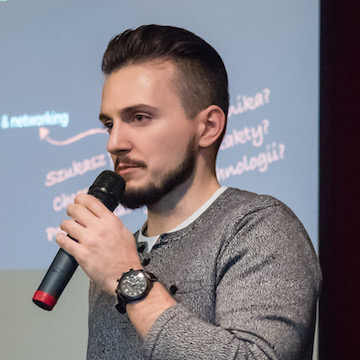javascript conference
// Poznań, Poland
After all taxes, "Akademia Przyszłości" got 45269.03 PLN to spend on helping children get on the right track to a safe and successful future! Thank you for your contributions!
The net total we spent on organizing the conference was less than that, so we're proud to report over 100% efficiency. It's the contribution of our great sponsors and attendees, so congratulations - you did much more than just participate in a conference!
Sponsors
agenda
// Poznań, Poland
main auditorium
Registration opens
Do not forget to bring your ticket! Only registered attendees are allowed to enter the venue.
Welcome to meet.js Summit 2018!
How is JavaScript similar to any foreign language you know
Joanna BochyńskaHave you ever thought that JavaScript can be treated as another foreign language? Do you know how many mechanisms in JS are similar to these that we may found in 'regular' languages? As a philologist and front-end developer I find new common things between these two areas in my everyday work. They don't stop to amaze me.
Let's take dialects as an example. Assuming you know Polish and go on holiday to the North of Poland. Do you understand people there? Oops... dialect is different! Of course, you can speak in Polish, they do understand you but some words are just different. Some people only speak the dialect, they don't bother to use Polish. Your 'pure' Polish is not enough. Polish is a light example, there are dialects that really differ from their 'mother language'. And the same with JavaScript. You know JavaScript and here home React, Angular, Vue or any other new fancy framework or library. Yes, you understand some parts but you have to dig deeper to discover main things that rule the framework.
What is also similar in JavaScript and foreign language? Logic, doing the same things in two different ways, having very similar way to do more than one thing and ...many more! I won't reveal all the secrets! I can only assure you that JavaScript can be treated as a foreign language and what we get as an output can be pretty exciting! In my presentation I will show how JS is similar to English, French, Hindi and any other language you know. With the examples! I will also tell you how to use these similarities to learn faster. Are you curious?
Give me a reason to learn some Reason
Bartosz KrólReason is a new programming language heavily invested by Facebook. Frontend world is finally getting a safe, fast and fun language which can also work with React by default. This talk will answer some questions like: "Why should I care about Reason?", "What can Reason give me?" and "How can I start?".
X-Team presentation
X-Team is the most energizing community on the planet for remote developers. Work on incredible projects. Travel the world together. Get a $2.5k/year stipend to spend on doing more of what you love. Commit, push, and unleash with the world's most motivated developers today. x-team.com/join
Structuring React components
Bartłomiej WitczakSince frontend becomes more and more complex, we need to focus more on architecture than before. SOLID principles should be considered when creating a new component. As there are many ways we can structure component, we need to think about how we want to use it. Definitely, we want components to be reusable, but only to the degree that is reasonable. We want to build small components that can be used to build bigger concepts. Ideally, we want to build loosely coupled & highly cohesive components, so our system is easier to maintain and grow. In React components props can be treated like function arguments and that’s exactly the case for functional stateless components. How we define props, defines how a component can be reused. Even though I'll present samples using React, I believe those principles are valid for every system, which consists of reusable structures.
Coffee Break
Pros and cons of integrating machine learning models on the frontend side.
Szymon FrąszczakI will mainly focus on the solution which we used in FANDOM to integrate a few machine learning models on the client side with AMD JavaScript modules in the production environment. I would like to present our approached for exporting already trained models (Scikit-Learn) to JavaScript (using sklearn-porter). During the talk, I will point out the consequences and limitations of using this solution. Moreover I would like to shortly discuss another approach we had, which was the separate service for exposing machine learning models and explain why we decided not to use already existing services such as TensorFlow Serving.
Browser-based Machine Learning with TensorFlow.js
Patryk OmiotekTensorFlow.js is JavaScript library which allows build and train models from scratch or run pre-existing models right in the browser or under Node.js. We can use sensor data connected to the browser, camera or other client-side data.
During this presentation I will show how and where we can use TensorFlow.js for solving Machine Learning problems and build interactive applications.
Testing more with less
Piotr BalbierTesting is dull. Testing is boring. Testing is tiring. I'll write tests later. Developers have many excuses to avoid writing comprehensive test suites, checking each happy path and each edge case to ensure the software is going to run fine. However, some tests so complex structures, that manual listing every edge case seems impossible. Generative testing is a method which provides an effective way to test functions with many possible edge cases basing on a set of invariants and declarative schemas and may help in hardening production code.
Lunch Break
Accessibility of Modern Web Applications: Case Study
Joanna KupisWhat makes web accessibility such a struggle? Why following accessibility patterns may be a way through torment? If you have ever tried to answer that and still don't know, then this talk is for you. If you have never heard of an accessibility issues then again this talk is just for you.
The talk will cover a real life example of a modal-like customized component supporting keyboard events. Those events follow chosen accessibility rules. By modifying base assumptions and expected behaviour of the component, we will find and (attempt to) fix many problems and inconveniences.
Frequently, in order to fulfill demanding business requirements developers are forced to abandon good practices and follow unexplored paths. In case of accessibility this trend is clearly visible and quite common as it will be proven during the talk.
How the Browser Sees Your Face
Mirosław CiastekSnapchat's Filters and Apple's Animoji are one of the most famous examples of computer vision in popular applications. Based on complex algorithms, computer vision can be intimidating at the first time. Luckily for us, Web Developers, processing images and face detection are much easier to work with than before.
Mainly a domain of native apps, face detection is now available in our browsers. Thanks to modern web APIs and libraries, we are now able to process the image in real time on the front-end side. With face detection, you can go even a one step further and make the browser to recognize your face!
This talk will give you a brief overview of face detection concepts. I will show you some popular methods of detecting the face using the web camera and how to use them in your applications.
Scale it the easy way - introduction to micro frontends
Jakub HolakWe have seen many benefits from introducing a microservice approach to our back-end architectures, but the UI layer is still often a monolithic app. Imagine a front-end development flow, with independent teams working on their parts separately and at their own pace, using their favorite tech stack. I would like to show you, that "micro frontends" is much more than a buzzword, and I bet on it becoming an important architectural approach in coming years. I will talk about a few possible tech stacks, focusing on how we can use web platform features to allow communication between micro-apps. Last but not least, I would love to share some thoughts on how my company benefits from this approach while rewriting a big internal app, having to still support the old one, and how we used a custom shell approach to make it possible.
Coffee Break
Write once, run anywhere - how does React XP manage to unify mobile and web development?
Anna KonopkaIf the concept of running one piece of code on your iPhone, Android and as a web app excites you, I think you might want to hear this talk. But be careful! Conference talks are usually meant to be spurs to dig into a new technology. This time I cannot promise you that.
We will be talking about how the multi-platform development looks in reality. I’ll tell you about the tools and techniques that we use to create apps for iOS, Android and web from one codebase. But at the same time I am going to share with you all the problems we’ve encountered and what we should have known when we started this journey. Is being JavaScript-speaking enough to build mobile apps? What can go wrong? Is it worth the fight? Let’s find out!
Styling React app with css-in-js library (emotion)
Przemek SuchodolskiIntroduction to css-in-js approach based on 'emotion' library. In this presentation you will learn why BEM is not enough in terms of big React app. How to increase the readability of your components. Unit tests for css? Yes! With css-in-js and snapshot testing it is available. Pros and cons of using css-in-js.
To infinity and beyond - scaling frontend development
Mateusz SzerszyńskiJira's new frontend codebase is quite young - it only has 2 years. Despite this it's growing pretty fast: currently repository has more than 1 million lines of code and 250 developers are working with it on a daily basis. In such a big codebase it is difficult to maintain the same architecture and standards as teams have different ideas of how their applications should look like. We needed to scale our development process and define practices which can help us build a world-class frontend product. Learn about our journey so far - the architecture of the product, rules which need to be respected, tools and scripts which help us adhere to the practices, our successes and obstacles that we had to overcome.
Good bye and see you in 2019!
After Party! FoodHall Poznań
speakers

Piotr Balbier
Software developer with .NET background, currently a full-time front-end developer at Netguru. Enthusiast of functional programming and code simplicity.

Joanna Bochyńska
Over two years ago I had decided to change my career and see what it was about coding. As a philologist, I was working in a big corporation in sales support. Next year was an amazing journey to me - I became front-end developer, focusing on JavaScript. I also started to share my thoughts about 'becoming a programmer' journey on my blog (wakeupandcode.pl). Moreover, I have noticed that there is not many female coders and this is why I started Facebook group "Programuj, dziewczyno!" ("Code girl") that today gathers other 14k of women interested in coding and is one of the biggest female oriented IT group in Poland. During these two years in IT industry I have noticed how amazing is the power of community. I started my own meet-ups, organised free basic programming trainings (via my blog & as part of girls.js organisation). I also created online course with programming basics. I want to share my knowledge and energy during meet.js and discover how does it feel to speak to such a big crowd :)

Mirosław Ciastek
I'm an experienced developer with various programming skills, including both front-end and back-end. I see browsers as a complex environment with unlimited possibilities. Thus, I like to play with the latest APIs to see what browsers have to offer. Recently I experimented with WebVR, and as a result, I co-organised WebVR meetup in Warsaw. Now, I help with microConf meetup series, as a speaker and organiser.

Szymon Frąszczak
I became a software engineer long time ago with a taste for programming. Currently I work mainly in the advertisement environment. It means that on daily basis I focus on implementation and maintenance of the ad stack products. While working for FANDOM in the Ad Engineering team I work mainly with frontend technologies but it does not mean that backend ones are not needed at all. To not constraint myself I got involved in a few machine learning projects in my current job. Moreover, as a second job or rather a hobby I am a full stack developer on the project which is about automation the apartment management. It is associated with design, implementation and maintenance whole service.

Jakub Holak
I am front-end developer with 10 years of professional experience, currently working at Nordcloud, where I am a part of R&D team. Web enthusiast, digging functional and reactive programming.

Anna Konopka
Senior frontend developer at Monterail. Vue and React advocate. Currently, developing mobile and web apps using React Native and React XP. Interested also in the backend world, especially in API design (GraphQL) and machine learning area. Apart from coding, she is trying to understand why some organisations and teams are successful and how they achieve that. She's blogging at kernelgonnapanic.pl.

Joanna Kupis
Frontend developer with the fondness for learning and experimenting. React enthusiast. Currently working for one of the fastest growing company in banking industry. PhD. student in Computer Science/Electronics. Developer of a software for ARUZ super-simulator at Lodz Univeristy of Technology.
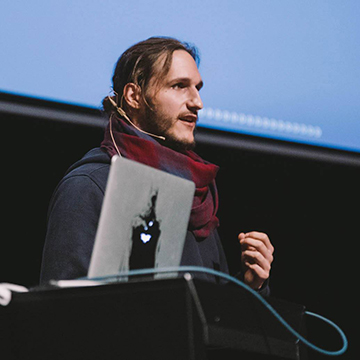
Bartosz Król
Software Engineer at X-Team. Huge GraphQL and reactive programming enthusiast. Loves learning new programming languages - aside from JavaScript works with Go and Elixir on everyday basics. Devoted LARP and RPG player.

Patryk Omiotek
Patryk is the programmer working in areas such as Data Science and Machine Learning. He gained his experience working for over 10 years as the full stack developer. Currently he is Cognitive Team Leader at intive where implements solutions for global brands and startups from Silicon Valley. He is also IT trainer at infoShare Academy and coordinator of "Lublin IT” meetups.

Przemek Suchodolski
Developer with passion and Agile mindset. Big fan of "clean code" and TDD approach. I have a blog (przemuh.pl) where you can find my Learning Log and other interesting stuff about JS, programming, scrum and music :) In my free time I like to play (the guitar && drums) || computer games ;)

Mateusz Szerszyński
Frond-end developer with a tendency to perfectionism and pixel-perfection, making Jira a great product. Big fan of Elvis Presley.

Bartłomiej Witczak
I believe there is no silver bullet. Everyday I learn new things and test different tools to be able to pick right tool for the particular job. After gaining experience both in startups and enterprise companies, I obtained technical knowledge and understood that team work is key aspect. I focus on clean architecture and high code quality.
venue

Poznań International Fair
ul. Głogowska 10, Poznań, Poland
Enter through the main entrance to the Fair (glass building). After going through the building, go left to the building number 15.
become-a-sponsor
Once a year as a meet.js community we organise a big conference called meet.js Summit attended by 500 professionals. We gather together in one city to discuss topics that have been trending for last 12 months. Tickets for our event get sold in 5 minutes.
meet.js Summit 2018 is the sixth instalment of the conference. At Summit you will meet experienced front-end developers and people fascinated by modern web technologies who constantly pursue to learn new things. They may be the ideal target of your recruitment process or a dream customer of your product. There are many case studies proving that attendees change their jobs after the conference and get motivated to take on new challenges in their careers.
Download our Sponsorship Packages (PDF) to find out more and contact us directly at sponsors@meetjs.pl to discuss sponsorship opportunities.
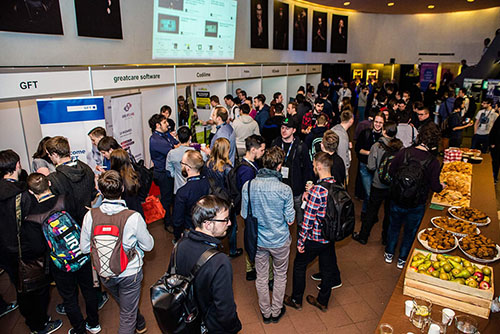

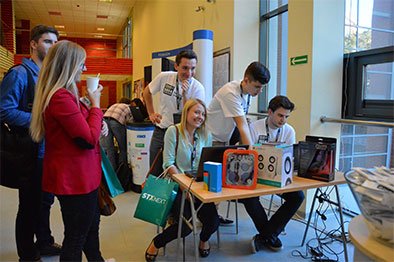
tickets
Tickets are now sold out!
All profits went to the "Akademia Przyszłości" mentoring program for kids
code-of-conduct
The primary goal of meet.js Summit 2018 is to be inclusive to the largest number of contributors, with the most varied and diverse backgrounds possible. As such, we are committed to providing a friendly, safe and welcoming environment for all, regardless of gender, sexual orientation, ability, ethnicity, socioeconomic status and religion (or lack thereof).
We invite all those who participate in our events to help us create safe and positive experiences for everyone.
Unacceptable Behavior
Unacceptable behaviors include: intimidating, harassing, abusive, discriminatory, derogatory or demeaning speech or actions, harmful or prejudicial verbal or written comments related to gender, sexual orientation, race, religion, disability; inappropriate use of nudity and/or sexual images (including presentation slides); inappropriate depictions of violence (including presentation slides); deliberate intimidation, stalking or following; harassing photography or recording; sustained disruption of talks or other events; inappropriate physical contact, and unwelcome sexual attention.
Consequences of Unacceptable Behavior
Unacceptable behavior from any community member, including sponsors and those with decision-making authority, will not be tolerated. Anyone asked to stop unacceptable behavior is expected to comply immediately.
If a community member engages in unacceptable behavior, the community organizers may take any action they deem appropriate, up to and including a temporary ban or permanent expulsion from the community without warning (and without refund).
If You Witness or Are Subject to Unacceptable Behavior
If you are subject to or witness unacceptable behavior, or have any other concerns, please notify an organizer as soon as possible. Organizers are wearing meet.js Summit 2018 t-shirt. You can also contact the organizers via Twitter @meetjs or email contact@meetjs.pl.
Organizers are available to help community members engage with local law enforcement or to otherwise help those experiencing unacceptable behavior feel safe. Organizers will also provide escorts as desired by the person experiencing distress.
See more at berlincodeofconduct.org.
about-us
meet.js is the name for JavaScript meetups in Poland, organised for programmers who are interested in JavaScript, HTML and CSS. Our events have been organised for over 7 years now in 13 major business hubs in the country (Gdańsk, Warsaw, Cracow, Poznań, Wrocław, Łódź, Katowice, Szczecin, Lublin, Białystok, Bydgoszcz, Bielsko-Biała and Toruń).
They are free of charge. An average number of attendees fluctuates between 100 and 200 guests per meetup, which makes meet.js one of the largest technical community in Europe . This is a perfect place for fostering your professional network as well as recruiting new candidates.
Want to support people who share front-end passion? Let's talk! Contact us at contact@meetjs.pl.







